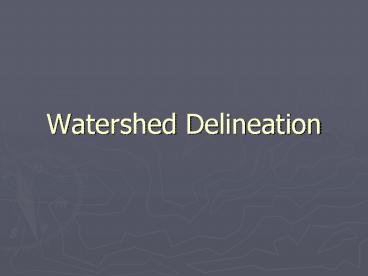Watershed Delineation Delineating Watersheds Watershed - PowerPoint PPT Presentation
1 / 29
Title:
Watershed Delineation Delineating Watersheds Watershed
Description:
Watershed Delineation Delineating Watersheds Watershed (Catchment, Drainage Basin): A topographically delineated area drained by a stream system, or, the total land ... – PowerPoint PPT presentation
Number of Views:1334
Avg rating:3.0/5.0
Title: Watershed Delineation Delineating Watersheds Watershed
1
Watershed Delineation
2
Delineating Watersheds
- Watershed (Catchment, Drainage Basin)
- A topographically delineated area drained by a
stream system, or, the total land above some
point, on a river/stream that drains past that
point. - Can range from a fraction of an acre to thousands
of square miles. - Why is this unit of area important to us as land
and water managers?
3
Delineating Watersheds Contd
- The watershed is a hydrologic unit of land used
as a physical, biological, socioeconomic, and
political unit for the management and planning of
natural resources. - Aids in describing and quantifying the variables
that influence water quality - Topography
- Soils
- Vegetation
- Land use, et.
4
Watershed Delineation
- Identifies the boundaries of our hydrologic unit
/ area of study.
5
Identifying Watershed Boundaries
- Steps to delineation
- Trace/outline outline the main stem of the stream
that you want to examine - Trace all perennial or influential tributaries
- Locate the lowest point/outlet of the main stem
and work uphill
6
Identifying Boundaries Contd
- Working uphill, Identify the ridges and hill tops
that divide the water from flowing into separate
watersheds - When in doubt, consider,
- Where will the rain drops go
7
Map Reading hints
- Water flows downhill (perpendicular to contours)
- Ridges make V shapes pointed downhill
- Draws make V shapes uphill
8
Area / Size
- Important to watershed features because
- Estimating total annual water yield
- Flood potential
- Hydro characteristics drainage density, time of
concentration, drainage shape, etc.. - Amount of ground that you must deal with
9
Methods to Determine Size
- Planimeter
- GIS
- Historical Data (USGS etc.)
- Dot method using a grid
10
GIS as a measuring tool
- Polygons have an area column
11
Aspect and Orientation
- Different watersheds have unique differences and
aspect has an affect - Watersheds with south facing slopes are dryer due
to evapotransperation and vegetation.
12
Aspect Calculation
- Direction
- Vector perpendicular to the plane of the slope
- Values 0-360 (degrees)
- Southern aspect is 180
360
180
Aspect Map
13
Aspect and Orientation
- Orientation- the General of the main stem of the
watershed - Obtain total stream length
- Determine 10 from the top and 15 from the
bottom - Connect these points and get the aspect of that
line
14
Watershed Orientation
- East/west orientation is likely to have slopes
that are predominantly north/south
15
Slope Calculation
- Rise over run
- Percent or angle
- Steepest point
If cells are 10 m2 then (7-3) / 10 .4100
40 slope
Slope map
16
Slope
- The vertical difference between the upper and
lower most points divided by the horizontal
difference in the points. - Why is slope important
- Runoff, stream transport power, sediment type and
load, aggrading or degrading. - Calculate for the entire reach and individual
sites.
17
Stream Profile
- Graph that provides longitudinal profile of the
stream. - X-axis is stream mileage
- Y-Axis is elevation
- Stream profiles help to stratify zones
- Alpine, foothills, basins
- Locate sample sites
- Zones of erosion etc.
18
Profile Contd
- Using a 124,000 or better map
- Record interval at contours
- Using a graphing program, create a line graph
with elevation as the y-axis and stream miles as
the x-axis
19
Sinuosity
- The repetition downstream of patterns of channel
curves for a given length of stream. (channel
length / valley length) - Measure of
- Bends
- Curves
- Meanders
- Sinuosity is important for
- Stream Classification
- Variation in erosion and sediment concentration
20
Calculating Sinuosity
- GIS
- Longitudinal Profiles in the field
- Standard Map and Map Wheels
21
Stream Order
- Characterizes the drainage networks
- Broad reference for flow characteristics of a
watershed - Higher streams usually mean higher flow volume
22
(No Transcript)
23
Calculating Stream Order
- Single tributaries are order 1 streams
- Two 1st order streams meeting order 2
- Two 2nd order streams meeting order 3
- 1st order meeting a 2nd order order 2
24
(No Transcript)
25
Watershed Shape
- Watershed shape has an effect on flow
characteristics - Shape can be calculated by form factors and
circulatory ratios - Circular watersheds will concentrate water
quickly and have a flashy discharge - Long narrow watersheds tend to have steep slopes,
high overland flow, high sediment yields, lower
peak volumes over long periods of time.
26
(No Transcript)
27
Relief Slope
Parent Material Soil Enhancement (3 layers)
Relief Relative Elevation
Organisms Fractional Vegetation
Relief Compound Topographic Index (acc. on
slopes perp. drain direction)
Climate/Relief Aspect
28
(No Transcript)
29
(No Transcript)































